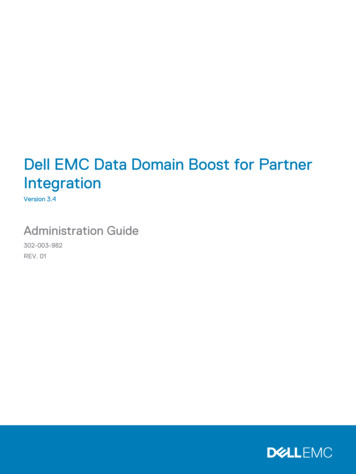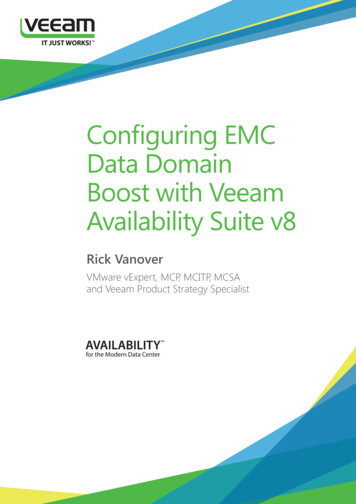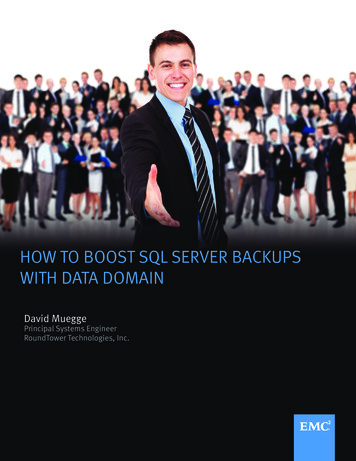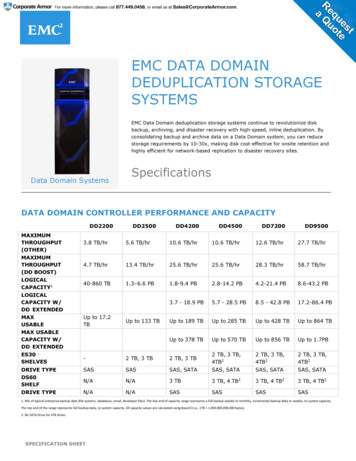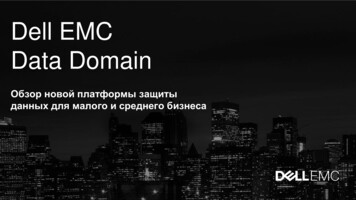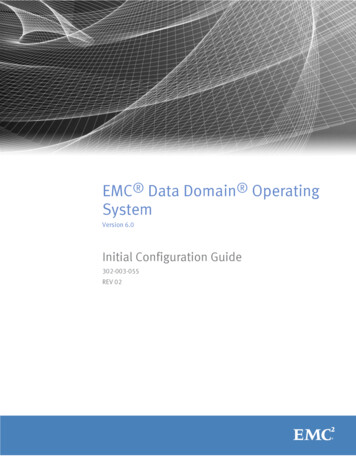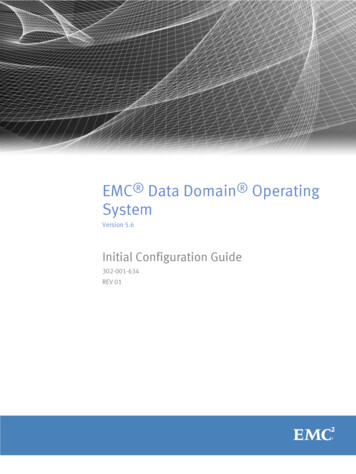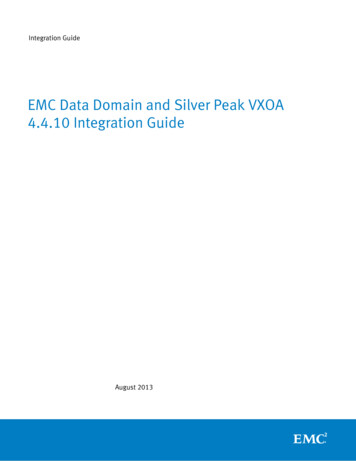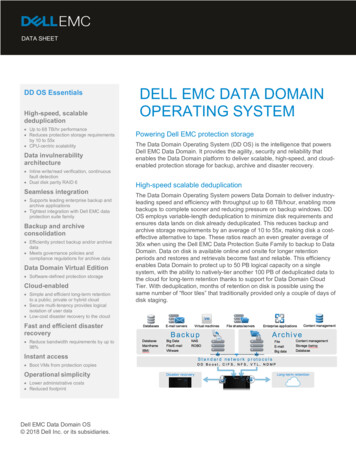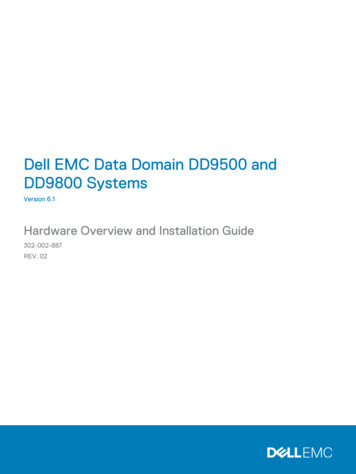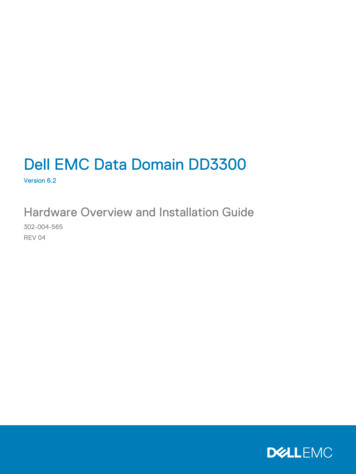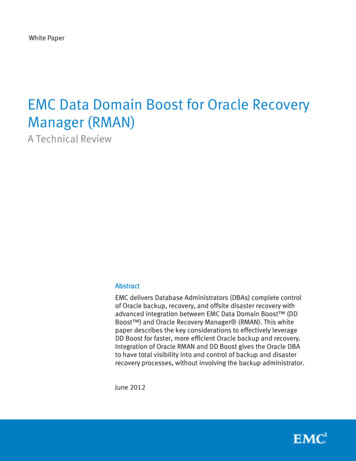
Transcription
White PaperEMC Data Domain Boost for Oracle RecoveryManager (RMAN)A Technical ReviewAbstractEMC delivers Database Administrators (DBAs) complete controlof Oracle backup, recovery, and offsite disaster recovery withadvanced integration between EMC Data Domain Boost (DDBoost ) and Oracle Recovery Manager (RMAN). This whitepaper describes the key considerations to effectively leverageDD Boost for faster, more efficient Oracle backup and recovery.Integration of Oracle RMAN and DD Boost gives the Oracle DBAto have total visibility into and control of backup and disasterrecovery processes, without involving the backup administrator.June 2012
Copyright 2012 EMC Corporation. All Rights Reserved.EMC believes the information in this publication is accurate asof its publication date. The information is subject to changewithout notice.The information in this publication is provided “as is.” EMCCorporation makes no representations or warranties of any kindwith respect to the information in this publication, andspecifically disclaims implied warranties of merchantability orfitness for a particular purpose.Use, copying, and distribution of any EMC software described inthis publication requires an applicable software license.For the most up-to-date listing of EMC product names, see EMCCorporation Trademarks on EMC.com.Oracle and Oracle Recovery Manager (RMAN) are registeredtrademarks or trademarks of Oracle, Inc. in the United Statesand/or other jurisdictions. All other trademarks used herein arethe property of their respective owners.Part Number h10683EMC Data Domain Boost for Oracle Recovery Manager (RMAN)A Technical Review2
ContentsExecutive Summary . 4The Solution . 4Introduction . 5Audience . 5Background. 5Oracle Backup and Recovery . 5EMC Data Domain Deduplication Systems . 5EMC Data Domain Boost – Advanced Integration with Oracle RMAN . 6Distributing the Deduplication Process . 7RMAN Managed File Replication . 8Advanced Load Balancing and Failover. 9Features and Benefits Summary . 10DD Boost for RMAN Configurations and Capabilities . 10Oracle Backup and Recovery Flexibility . 11EMC NetWorker and EMC Avamar . 11Centralizing Management of Backups . 12EMC Data Protection Advisor for Oracle RMAN and Data Domain . 12Conclusion . 13Appendix . 14Best Practice – Optimizing Data Deduplication . 14Additional Resources . 15List of FiguresFigure 1: DD Boost for Oracle RMAN Solution Overview . 7Figure 2: RMAN Backup to Data Domain without DD Boost . 7Figure 3: RMAN Backup to Data Domain with DD Boost . 8Figure 4: DD Boost - Managed File Replication Workflow . 9EMC Data Domain Boost for Oracle Recovery Manager (RMAN)A Technical Review3
Executive SummaryBusinesses and government entities worldwide run Oracle databases to support theirmission-critical applications. Not only are these applications the least tolerant ofdowntime, they often generate high rates of data growth. Oracle applications typicallyrun the business from order entry to payroll and accounts receivable, as well asmanufacturing assembly lines. Maintaining service level agreements (SLAs) for Oracledatabases is vital to corporate health and sustainability. However, exponential datagrowth and shrinking backup windows are putting SLAs at risk.Many IT organizations perform full Oracle backups on a nightly basis – often togetherwith an incremental backup strategy throughout the day. To meet their backup andrecovery requirements, most businesses store these backups for 30 days or more.Unfortunately this leads to rapid growth in backup storage requirements, which haskept some users stuck with legacy tape systems as the default solution for databasebackup. However, this reliance on tape can limit the number of backups that can beperformed, impacting recovery point objectives (RPOs).In addition, DBA’s are constantly challenged to improve recovery time objectives(RTOs). Recovering Oracle from full and incremental backups, then rolling the archive/ redo logs forward is time consuming and complex. However, restoring the databasein the shortest possible time is essential to business operations.The SolutionEMC Data Domain deduplication storage systems continue to revolutionize diskbackup, archiving, and disaster recovery with high-speed, inline deduplication. Fornearly a decade, Data Domain systems have brought autonomy and control to Oracledatabase administrators (DBAs) by supporting Oracle Recovery Manager (RMAN)backups that write directly to the Data Domain system via a CIFS share or NFS mountwithout the use of a backup application. The high-speed, inline, deduplicationcapabilities of Data Domain systems have enabled DBAs to deal with the exponentialdata growth, and the reliability issues and operational inefficiencies of magnetic tapeoperations. Data Domain systems provide operationally superior and cost effectivedisaster recovery.EMC Data Domain Boost integration with Oracle Recovery Manager provides theindustry’s first solution that gives database administrator complete control of backupand disaster recovery processes. DD Boost for RMAN provides a faster, more efficientOracle backup and recovery solution.EMC Data Domain Boost for Oracle Recovery Manager (RMAN)A Technical Review4
IntroductionThe purpose of this white paper is to exemplify how DD Boost provides unique andpowerful integration between Oracle RMAN and Data Domain systems. The goal is tobetter serve database administrators in their challenge of keeping the companyrunning with this business critical application.AudienceThis white paper is intended for Oracle database administrators, technicalconsultants, partners and members of the EMC and partner professional servicescommunity who are looking for faster, more efficient Oracle backup and recovery withcomplete control over Oracle disaster recovery procedures.BackgroundOracle Backup and RecoveryOracle Recovery Manager (RMAN) is a native utility from Oracle that is designed foronline (hot) backup and recovery of Oracle database files. RMAN is built into Oracleand does not require separate licensing or installation. RMAN metadata is stored inthe Oracle control file of the database being backed up and optionally in a recoverycatalog database within Oracle. This cataloged metadata can be browsed during arestore. RMAN can be managed from Oracle Enterprise Manager or from the Oraclecommand line interface. Oracle RMAN is a pre-requisite to efficiently backup andrecover Oracle databases.Oracle RMAN Block Change Tracking (BCT) optimizes incremental backups by utilizinga tracking file to keep a record of blocks that have changed within each datafile sincethe last backup. The tracking file is read during an incremental backup to avoidhaving to read each data file individually to identify which blocks have changed.EMC Data Domain Boost for RMAN is compatible with Oracle BCT. With DD Boost forRMAN configured and BCT enabled, and an incremental backup is run, the RMANscript will direct the backup to read the tracking file. Only unique data segments willbe copied to the Data Domain system, without the need to scan the complete filesystem.EMC Data Domain Deduplication SystemsData Domain deduplication storage systems offer a cost-effective alternative to tapethat allows users to enjoy the retention and recovery benefits of inline deduplication,as well as network-efficient replication over the wide area network (WAN) for disasterrecovery (DR).Data Domain systems reduce the amount of disk storage needed to retain and protectdata by 10 to 30 times. Data on disk is available online and onsite for longerretention periods, and restores become fast and reliable. Storing only unique data ondisk also means that data can be cost-effectively replicated over existing networks toEMC Data Domain Boost for Oracle Recovery Manager (RMAN)A Technical Review5
remote sites for DR. With the industry’s fastest deduplication storage controller, DataDomain systems allow more backups to complete faster while putting less pressureon limited backup windows.All Data Domain systems are built as the data store of last resort, which is enabled bythe EMC Data Domain Data Invulnerability Architecture – end-to-end data verification,continuous fault detection and self-healing, and other resiliency features transparentto the application.Data Domain Boost extends the Data Domain Data Invulnerability Architecture bygenerating checksums on the Oracle server before RMAN sends data to the DataDomain system. The Data Domain system receiving the data computes newchecksums on the incoming data and compares them to the computed values fromthe backup application, ensuring inline verification of data.For more information on Data Domain Data Invulnerability Architecture, click papers/h7219-data-domain-datainvul-arch-wp.pdfEMC Data Domain Boost – Advanced Integration with OracleRMANEMC Data Domain Boost for Oracle Recovery Manager is an industry first to delivercomplete control of Oracle backup and disaster recovery, enabling DBAs to haveconfidence in self-administered recovery from the local or the DR site. DD Boost forRMAN enables Oracle database administrators (DBAs) to manage their backup,operational recovery, and disaster recovery processes without dependence on abackup administrator.In addition, DD Boost for RMAN accelerates backup performance (up to 50 percentfaster than NFS), enables more backups with existing resources and simplifiesadministration.Implementing DD Boost for RMAN simply requires installing the DD Boost plug-in onthe Oracle server, and then the DD Boost plug-in interfaces between the Oracle MediaManagement Layer (MML) API (also known as the Simple Backup to Tape or “SBT”API) and DD Boost (see Figure 1 below). The Oracle MML API allows backupapplications to interface with Oracle RMAN.EMC Data Domain Boost for Oracle Recovery Manager (RMAN)A Technical Review6
Figure 1: DD Boost for Oracle RMAN Solution OverviewDistributing the Deduplication ProcessPrior to DD Boost, Oracle Recovery Manager would send all data, unique orredundant, to a Data Domain system for deduplication processing, as shown in figure2 below. With DD Boost, Oracle servers send only unique data segments to the DataDomain system.Figure 2: RMAN Backup to Data Domain without DD BoostEMC Data Domain Boost for Oracle Recovery Manager (RMAN)A Technical Review7
DD Boost for RMAN significantly increases performance by distributing parts of thededuplication process to the DD Boost plug-in on the Oracle server, as shown inFigure 3.Figure 3: RMAN Backup to Data Domain with DD BoostWith DD Boost, Oracle servers send only unique data segments to the Data Domainsystem. By sending only unique data, DD Boost decreases the load on the Oracleserver since sending data is significantly more CPU and memory intensive thanexecuting parts of the deduplication process.In addition to performance improvements, the amount of data transferred over theLAN is greatly reduced. This optimized efficiency enables substantially more backupswith existing Oracle database server(s) and Ethernet networks.RMAN Managed File ReplicationEMC Data Domain Replicator software provides network-efficient, automated, andencrypted replication for disaster recovery, copying only unique and compressed datasegments to a remote Data Domain system. With DD Boost for RMAN, DBAs gain fullvisibility and control of these disaster recovery processes via DD Boost managed filereplication.Configuring DD Boost managed file replication is simple and starts with setting up DDReplicator software using the Data Domain Enterprise Manager console and CLI.Then, to setup RMAN to manage Data Domain replication, simply define abackup.cmd file in RMAN to enable the remote Data Domain system as the target forreplication. As each RMAN file write completes on the primary Data Domain systemduring backup, replication automatically begins to send only unique and compresseddata segments to the remote Data Domain system. Remote backup copies areimmediately visible to the Oracle server and available for recovery, providing faster“time-to-DR” readiness.Figure 4 below, depicts the workflow that is transparently executed with managed filereplication, from the Oracle server.EMC Data Domain Boost for Oracle Recovery Manager (RMAN)A Technical Review8
Figure 4: DD Boost - Managed File Replication WorkflowDD Boost – Managed File Replication Steps1. RMAN performs the backup through the DD Boost plug-in resulting in:50 percent faster performanceUp to 99 percent less LAN bandwidth requirementsBetween 20 to 40 percent less CPU resource load on the Oracle server2. When each RMAN file write completes on the local Data Domain system,network-efficient replication automatically and transparently begins to copythe unique and compressed file segments to the remote Data Domain system3. When the RMAN backup to the local Data Domain system as well as replicationto the remote Data Domain system are complete, the RMAN catalog is updatedwith information about both the local and remote backup copiesIn addition, with the EMC Data Domain Encryption software option, deduplicated datacan be encrypted inline before landing on the Data Domain system. Similarly, DDReplicator can encrypt and decrypt data in-flight when replicating between DataDomain systems. These encryption options can be enabled separately or concurrentlyto achieve different security goals.Advanced Load Balancing and FailoverDD Boost provides application-aware load balancing and failover of multiple 1GbE or10GbE links. This feature provides automatic distribution of backup and restore jobsand dynamic load balancing on multiple ports on the Data Domain system.The DD Boost plug-in negotiates with the Data Domain system for an interface anddistributes the load based on the number of jobs scheduled on a particular interface.In addition, DD Boost provides automatic link failover by transparently moving jobson failed links to healthy links, which speeds backups by increasing reliability andfault tolerance.In addition, DD Boost reduces complexity by eliminating the need to hard mount aData Domain system through NFS. Due to this simplification, DD Boost automatic linkfailover eliminates the risk of hard mount failures bringing down the entire database.EMC Data Domain Boost for Oracle Recovery Manager (RMAN)A Technical Review9
Features and Benefits ss50 percent faster performance versus NFSOracle ManagedReplicationOracle database administrator control of replication processUp to 99 percent less LAN bandwidth required20 to 40 percent CPU utilization improvement on Oracle serverImprove RPO and RTO service level agreementsNetwork-efficient replication copies only unique, compresseddata segments to the remote Data Domain system for faster“time-to-DR” readinessBoth local and remote backup copies are visible in the OracleRMAN catalogRestores can be initiated using backup filesets from either thelocal or remote Data Domain systemAdvanced LoadBalancing and LinkFailoverApplication-aware aggregation of multiple 1GbE or10GbE linksEase of UseDBA-controlled simplified managementBackup and restore jobs load are automatically distributedon multiple ports on the Data Domain systemIn-flight jobs on failed ports on a Data Domain system aretransparently moved to healthy linksCompatible with switch assisted aggregationNo dependency on backup applicationsEliminates mount point failures and uses standardscriptingRich OracleEnvironment SupportSee the online support matrix for details athttps://my.datadomain.com/US/en/search.jspDD Boost for RMAN Configurations and CapabilitiesDD Boost for Oracle RMAN supports a number of commonly deployed configurations andcapabilities:1. Backup and recovery of Oracle 10g and 11g databases (Oracle RAC, Oracledatabase appliance and Exadata configurations)o Full backup and Incremental backup with Oracle Block Change Trackingo Frequent backup, faster restoreso Short and long-term retention of database backupsEMC Data Domain Boost for Oracle Recovery Manager (RMAN)A Technical Review10
2. Backup and recovery of multiple Oracle databases with different SID’s withinan instance3. Backup and recovery of multiple distinct Oracle databases using a centralizedRMAN backup server (typically seen in service provider deployments)4. Backup replication for disaster recovery for Oracle databases5. Refresh test and development instances from local or remote backup copiesOracle Backup and Recovery FlexibilityIn addition to DD Boost for RMAN, EMC offers a variety of other Oracle backupsolutions using a Data Domain system:DD Boost for EMC Avamar , EMC NetWorker , Symantec NetBackup and BackupExec Direct backups via NFS, dNFS and CIFSEMC backup and recovery solutions allow enterprises to choose the best approach fortheir specific environment and requirements.EMC NetWorker and EMC AvamarSome corporate policies may dictate that the backup administrators must retaincontrol of all backup and recovery processes. In this case, DD Boost for NetWorker orAvamar provides benefits that are similar to those listed above, but allow the backupadministrators to retain the control.EMC NetWorkerDD Boost for NetWorker distributes parts of the deduplication process to either aNetWorker storage node or directly to an Oracle server via the EMC NetWorkerModule for Databases and Applications (NMDA).With DD Boost, backup administrators can gain faster, more efficient Oraclebackup and manage Data Domain replication for catalog consistent disasterrecovery.EMC AvamarAvamar enables fast, efficient backup and recovery for Oracle data by reducingthe size of backup data at the client before it is transferred across the networkand stored. Avamar integrates with Data Domain via DD Boost software to allowusers to enjoy the Data Domain system’s scale and performance as well as thesimplicity and network efficiency enabled by Avamar. DD boost
EMC Data Domain Boost for Oracle Recovery Manager is an industry first to deliver complete control of Oracle backup and disaster recovery, enabling DBAs to have confidence in self-administered recovery from the local or the DR site. DD Boost for

